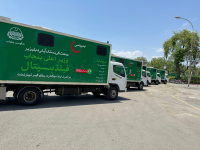I got called a "bitch a** ni**a" for saying that Elahi and SS's administrations were not as bad for Punjab. The administrations from 2000 to 2018 were not as incompetent as they are portrayed by PTI supporters (not for all of Pakistan, but specifically for Punjab—although the federal ones were inept). Despite the terrible growth rates we have witnessed since the late 2000s until now, compared to at least what came before them—the lost decade of the 90s and now instability of 2018-2023.
Over the years, I have bookmarked some of these articles, but now I have decided to gather all of these articles and graphs and copy paste them into crappy writeup of sorts- so they kinda follow a structure, highlighting the more important parts. This way, you don't have to read everything, just the highlighted parts and graphs to understand the gist of my main point.
We'll judge our provincial governments from 2000-2018 by three standards: education, health, and law & order, as that's the provincial domain.
This is my way of saying- its wrong to assume that they did nothing, they just sat around and people voted for them because ppl are "ghulams" of Elahi, SS style of politics (whatever that may entail)
We (or vast majority of Punjab) voted PTI for its anti-establishment stance, end to puppet PM's not sharifon, elahi (back in the day) ke ghulam crap
Health
During the last 18 years every district of Punjab was given a main Gov hospital to serve the need of the district and serve as the heart of the larger healthcare system of that district - thats why the name District headquarter hospital before 2000s a lot of districts didn't have this facility

pshealthpunjab.gov.pk
Before Rescue 1122 we had no EMS in Punjab nor fire brigade service
Think of all the road accidents and properties they saved, they were game changers during the flood relief efforts
It was started in 2004 and by 2018 not only was this service available in all districts of Punjab in some capacity but they were also training other provinces and countries due to their high professional standards
There's more to write here with the healthcard program, expansion of PHC unit program- all of these interventions had a direct impact from the lows of 80s,90s due to the expansion of our healthcare network through public private partnership in the 2000s and most of 2010s
All of it is here - look through it if you want - but you see Crazy % of catching up in the 2000s in almost every health metric from where we were before Elahi, Shehbaz times (from 70s,80s,90s our government really didn't give a crap if we truly look at the data)- as a sample example our child vaccination in the 90s was 35% now its at 80%, in the 90s only 13% of the women delivered babies at a health facilities now ⅔ women use a health care facility as our healthcare infrastructure has expanded a lot after the 2000s due to PPP model, there's more but its just to illustrate the larger point
Education from 2000 to 2018 (wont post everything just the more important parts, to not make it boring)
Bringing 13 million more children into school: Lessons from Punjab
Well, upon reflection, the reality is much more mixed when we consider the challenge of
population growth.
Source: Authors estimations based on population censuses and household surveys (PSLM, HIES, DHS)
Case in point is the Punjab province, which contains over half of Pakistan’s
growing population. Combining census data with household surveys,
Punjab expanded schooling from 13 million students in 1998 to 26 million students by 2020 over the last 20 years, effectively doubling the number of children aged 6-15 in school . Household surveys show an increase in the share of children enrolled by about 19 percentage points.
…
Source: Authors estimations based on population censuses and household surveys (PSLM, HIES, DHS)
Remarkably, the growth is largest for girls, with an estimated 24 percentage point increase in enrolment --versus 15 percentage points for boys. In other words, Punjab is quickly developing down the path of modernization.
Punjab followed randomized evidence, using data to track progress….
First, at the heart of these series of reforms was sustained political leadership and commitment to education. The Government of Punjab placed school access at the center of the education policy and in 2003, made education free for all at the point of access. This meant that students didn’t pay tuition and received free textbooks.
The Government of Punjab also made institutional changes, creating a monitoring and implementation arm that was independent from the education bureaucracy and devolving financing to district governments through performance-linked budgeting.
Second, Punjab has made strategic financial investments in programs that were shown to work.
…. The province also provided conditional cash transfers for girls’ education and expanded school participation for girls regularly attending schooling from grades 6-10. This program increased middle school enrollment for girls by
10 percentage points in just two years from 2003 to 2005, increased completion rates by 4.5 percent,... the province also used budgetary support to scale a
Public Private Partnership (PPP) model across the province to provide schooling to about 2.5 million students… Third, the government actively reached out to parents and households through a school council mobilization program.
An evaluation of the program found that
student enrollment increased by 5.7% relative to baseline enrollment, with a particularly large increase for girl’s enrollment of 12.4 percent.
… Expanding education for 13 million additional children is no small feat. To illustrate, this is the size of a schooling population of an average middle-sized country (Vietnam’s schooling population is about 14 million students, Germany’s is about 12 million children). In other words, the Punjab province now provides new learning opportunities to a cohort that’s equivalent to a major countries’ entire student population! Not for nothing has the Punjab’s reform program been described as having been the ‘
most frenetic education reforms in the world’.
https://blogs.worldbank.org/endpove...3-million-more-children-school-lessons-punjab
Pakistan is home to the most frenetic education reforms in the world
Reformers are trying to make up for generations of neglect
In April 2016, as part of its latest scheme, private providers took over the running of 1,000 of the government’s primary schools. Today the number is 4,300. By the end of this year, Mr Sharif has decreed, it will be 10,000. … Leaders of struggling districts are called to Lahore for what Allah Bakhsh Malik, Punjab’s education secretary, calls a “pep talk”. Asked what that entails, he responds: “Four words: F-I-R-E. It is survival of the fittest.” About 30% of district heads have been sacked for poor results in the past nine months, says Mr Malik. “We are working at Punjabi speed.”... The Punjab Education Foundation (PEF), another quasi-independent body, oversees some of the largest school-privatisation and school-voucher programmes in the world. It has a seat with the ministers and administrators at Mr Sharif’s quarterly meetings. The Punjab government no longer opens new schools; all growth is via these privately operated schools. Schools overseen by PEF now teach more than 3m children (an additional 11m or so in government schools)
…. The latest stocktake claimed an “unprecedented” 10% increase in primary-school enrolment since September 2016, an extra 68,000 teachers selected “on merit”, and a steady increase in the share of correct answers on a biannual test of literacy and numeracy.
https://www.economist.com/briefing/...-most-frenetic-education-reforms-in-the-world
We are one of the few provinces where literacy rate is almost stagnant since 2018
In 2023 our literacy increased from 66.01 to 66.3 ONLY .02% increase
Our literacy rate in 2017 was 64.7% -so in 5-6 years we only increased by 1.6%!
2015-2018 % increase in literacy rate alone was around 3%, if you take it back to ‘98 it was around 46%- In 2018 around 65%
In those 2 decades our yearly % increase was around 1% or .95% specifically (by sheer numbers it was a lot but due to our high TFR especially back then, % wise it doesn't look as good) - but from 2018-2023 - overall cumulative total was just 1.6%.
https://www.dawn.com/news/1487420
https://www.dawn.com/news/1774854#:~:text=ISLAMABAD: At a time when,the Economic Survey 2022-23.
Higher education
I looked up the data for universities in Punjab and when they were established with 1998 as the cutoff year to Judge to 2 decades of 98-till 2018 Panjab- heres what I found
From 1998 till now - Government of Panjab built 55 universities in total
From 1860-1998 our total universities were -35
So in 2 decades we built almost 1.5x more universities in Panjab than through out higher education history going all the way back to the british times (afaik these are HEC recognized ones only not every crappy private university throughout Punjab, that number higher)
In 2004 no pakistani university was in top 1000 now we have 4 from Punjab, 4 Islamabad - 10 overall (but tbh 80% credit goes to Musharaf admin here not CM’s, his HE reforms led to this but provinces still have a role to play in HE too although they were not responsible for these reforms)
If our IT exports grow to the much touted number of $10 B, you’ll see most of it will be from urban Punjab too because of the mush/Elahi era work on HE
https://www.universityrankings.ch/results?ranking=QS®ion=World&year=2024&q=Pakistan
Law & order- Our sectarian violence came down from the highs of the 90s, The Punjabi Taliban phenomenon of 2010s was handled mostly by police, LEA’s(almost no direct army involvement), The katcha ke Dacoo are a menace in Punjab but they are not as powerful in districts of Punjab than they are compared to the same neighboring districts of Sindh with similar people, culture, geography, safe city project was launched first in Lahore - now its being expanded to 17 cities of Punjab and 2.5 million private cameras were also added in as well.
Transportation
Metro train was the dumbest thing anyone could do but BRT was not as it was relatively cheap and a great public transportation service for a developing province.
We have BRT in 3 cities - Multan, Lahore, Pindi with Faisalabad one being planned.
Almost a million riders a day, if we keep expanding realitively inexpensive PT service than we can solve a lot of our urban transportation problems.

In 1995 our HDI levels were just above Balochistan and slightly above sindh by a decimal point, In 2021 our HDI levels are 3rd highest after AJK,slightly below GB. Amongst all 6-7 administrative unit including Islamabad,AJK from 1995- till 2021 we improved the most with 0.146 points.
@PakCan @RazPaK @Meengla @Mr X @MS Sandhu @Mustang125























